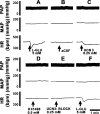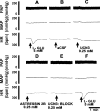Bradycardic effects of microinjections of urocortin 3 into the nucleus ambiguus of the rat
- PMID: 23019211
- PMCID: PMC3517671
- DOI: 10.1152/ajpregu.00224.2012
Bradycardic effects of microinjections of urocortin 3 into the nucleus ambiguus of the rat
Abstract
The presence of urocortin 3 (UCN3) and CRF2 receptors (CRF2R) has been demonstrated in brain tissue. Nucleus ambiguus (nAmb) is the predominant brain area providing parasympathetic innervation to the heart. On the basis of these reports, it was hypothesized that activation of CRF2Rs in the nAmb may elicit cardiac effects. Experiments were carried out in urethane-anesthetized, artificially ventilated, and adult male Wistar rats. Microinjections of l-glutamate (l-GLU, 5 mM) were used to identify the nAmb. Different concentrations of UCN3 (0.031, 0.062, 0.125, 0.25, and 0.5 mM) microinjected into the nAmb elicited decreases in heart rate (HR) (5.3 ± 1, 22 ± 3.3, 38 ± 4.9, 45.7 ± 2.7, and 27.3 ± 2.3 bpm, respectively). The volume of all microinjections was 30 nl. Blood pressure changes concomitant with decreases in HR were not observed. Bradycardia elicited by microinjections of UCN3 (0.25 mM; maximally effective concentration) into the nAmb was significantly (P < 0.05) attenuated by microinjections of selective CRF2R antagonists (K41498, 0.5 mM, and astressin 2B, 0.25 mM) at the same site. Bilateral vagotomy abolished the bradycardic responses to UCN3. These results indicated that activation of CRF2Rs in the nAmb by UCN3 elicited bradycardia, which was vagally mediated. UCNs have been reported to exert cardioprotective effects in heart failure and ischemia/reperfusion injury. In this situation, centrally induced bradycardia by UCN3 would be beneficial. The results of the present investigation provide a platform for future studies on the role of CRF2Rs in the nAmb in pathological states such as heart failure.
Figures







Similar articles
-
Microinjections of urocortin1 into the nucleus ambiguus of the rat elicit bradycardia.Am J Physiol Heart Circ Physiol. 2011 Jan;300(1):H223-9. doi: 10.1152/ajpheart.00391.2010. Epub 2010 Oct 15. Am J Physiol Heart Circ Physiol. 2011. PMID: 20952663 Free PMC article.
-
Cardiovascular responses to microinjections of urocortin 3 into the nucleus tractus solitarius of the rat.Am J Physiol Heart Circ Physiol. 2009 Feb;296(2):H325-32. doi: 10.1152/ajpheart.01044.2008. Epub 2008 Dec 5. Am J Physiol Heart Circ Physiol. 2009. PMID: 19060121 Free PMC article.
-
Microinjections of alpha-melanocyte stimulating hormone into the nucleus ambiguus of the rat elicit vagally mediated bradycardia.Am J Physiol Regul Integr Comp Physiol. 2009 May;296(5):R1402-11. doi: 10.1152/ajpregu.90978.2008. Epub 2009 Mar 18. Am J Physiol Regul Integr Comp Physiol. 2009. PMID: 19297540 Free PMC article.
-
Mechanisms of cardiovascular actions of urocortins in the hypothalamic arcuate nucleus of the rat.Am J Physiol Heart Circ Physiol. 2013 Jul 15;305(2):H182-91. doi: 10.1152/ajpheart.00138.2013. Epub 2013 May 17. Am J Physiol Heart Circ Physiol. 2013. PMID: 23686711 Free PMC article.
-
Cardiovascular responses to microinjections of urocortins into the NTS: role of inotropic glutamate receptors.Am J Physiol Heart Circ Physiol. 2009 Jun;296(6):H2022-9. doi: 10.1152/ajpheart.00191.2009. Epub 2009 Apr 24. Am J Physiol Heart Circ Physiol. 2009. PMID: 19395554 Free PMC article.
Cited by
-
GABA and glycine receptors in the nucleus ambiguus mediate tachycardia elicited by chemical stimulation of the hypothalamic arcuate nucleus.Am J Physiol Heart Circ Physiol. 2015 Jul 1;309(1):H174-84. doi: 10.1152/ajpheart.00801.2014. Epub 2015 May 8. Am J Physiol Heart Circ Physiol. 2015. PMID: 25957221 Free PMC article.
-
Nesfatin-1 activates cardiac vagal neurons of nucleus ambiguus and elicits bradycardia in conscious rats.J Neurochem. 2013 Sep;126(6):739-48. doi: 10.1111/jnc.12355. Epub 2013 Jul 19. J Neurochem. 2013. PMID: 23795642 Free PMC article.
-
Corticotropin releasing factor excites neurons of posterior hypothalamic nucleus to produce tachycardia in rats.Sci Rep. 2016 Feb 1;6:20206. doi: 10.1038/srep20206. Sci Rep. 2016. PMID: 26831220 Free PMC article.
-
Urocortin 3 elevates cytosolic calcium in nucleus ambiguus neurons.J Neurochem. 2012 Sep;122(6):1129-36. doi: 10.1111/j.1471-4159.2012.07869.x. Epub 2012 Aug 3. J Neurochem. 2012. PMID: 22774996 Free PMC article.
-
Evidence for role of acid-sensing ion channels in nucleus ambiguus neurons: essential differences in anesthetized versus awake rats.J Comp Physiol B. 2014 Aug;184(6):753-61. doi: 10.1007/s00360-014-0829-9. Epub 2014 Apr 22. J Comp Physiol B. 2014. PMID: 24752669 Free PMC article.
References
-
- Aguilera G, Nikodemova M, Wynn PC, Catt KJ. Corticotropin releasing hormone receptors: two decades later. Peptides 25: 319–329, 2004 - PubMed
-
- Batten TF. Immunolocalization of putative neurotransmitters innervating autonomic regulating neurons (correction of neurones) of cat ventral medulla. Brain Res Bull 37: 487–506, 1995 - PubMed
-
- Bieger D, Hopkins DA. Viscerotopic representation of the upper alimentary tract in the medulla oblongata in the rat: The nucleus ambiguus. J Comp Neurol 262: 546–562, 2006 - PubMed
Publication types
MeSH terms
Substances
Grants and funding
LinkOut - more resources
Full Text Sources

